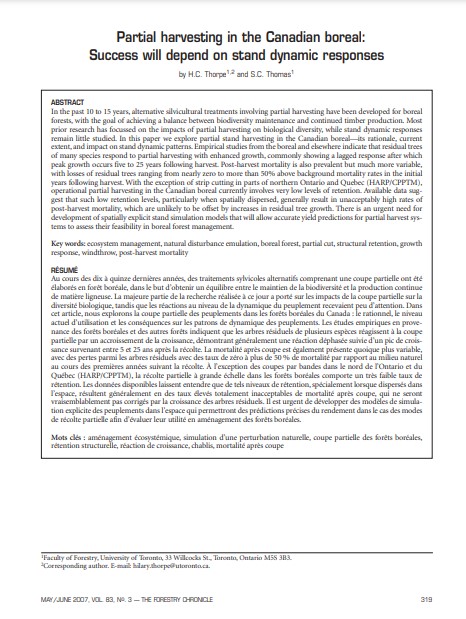Partial harvesting in the Canadian boreal: Success will depend on stand dynamic responses
Bosque Modelo:
Lake Abitibi
Temática:
Gestión forestal
Tipo de documento:
Artículo científico
Resumen
In the past 10 to 15 years, alternative silvicultural treatments involving partial harvesting have been developed for boreal forests, with the goal of achieving a balance between biodiversity maintenance and continued timber production. Most prior research has focussed on the impacts of partial harvesting on biological diversity, while stand dynamic responses remain little studied. In this paper we explore partial stand harvesting in the Canadian boreal—its rationale, current extent, and impact on stand dynamic patterns. Empirical studies from the boreal and elsewhere indicate that residual trees of many species respond to partial harvesting with enhanced growth, commonly showing a lagged response after which peak growth occurs five to 25 years following harvest. Post-harvest mortality is also prevalent but much more variable, with losses of residual trees ranging from nearly zero to more than 50% above background mortality rates in the initial years following harvest. With the exception of strip cutting in parts of northern Ontario and Quebec (HARP/CPPTM), operational partial harvesting in the Canadian boreal currently involves very low levels of retention. Available data suggest that such low retention levels, particularly when spatially dispersed, generally result in unacceptably high rates of post-harvest mortality, which are unlikely to be offset by increases in residual tree growth. There is an urgent need for development of spatially explicit stand simulation models that will allow accurate yield predictions for partial harvest systems to assess their feasibility in boreal forest management.
Información Bibliográfica
Autor:
Thorpe, HC and SC Thomas.
Revista:
Forestry Chronicle
Año:
2007
N°:
3
País :
Canadá
Páginas:
319 - 325
Volumen:
83
Idioma:
Ingles
Palabras claves
ecosystem management, natural disturbance emulation, boreal forest, partial cut, structural retention, growth response, windthrow, post-harvest mortality





